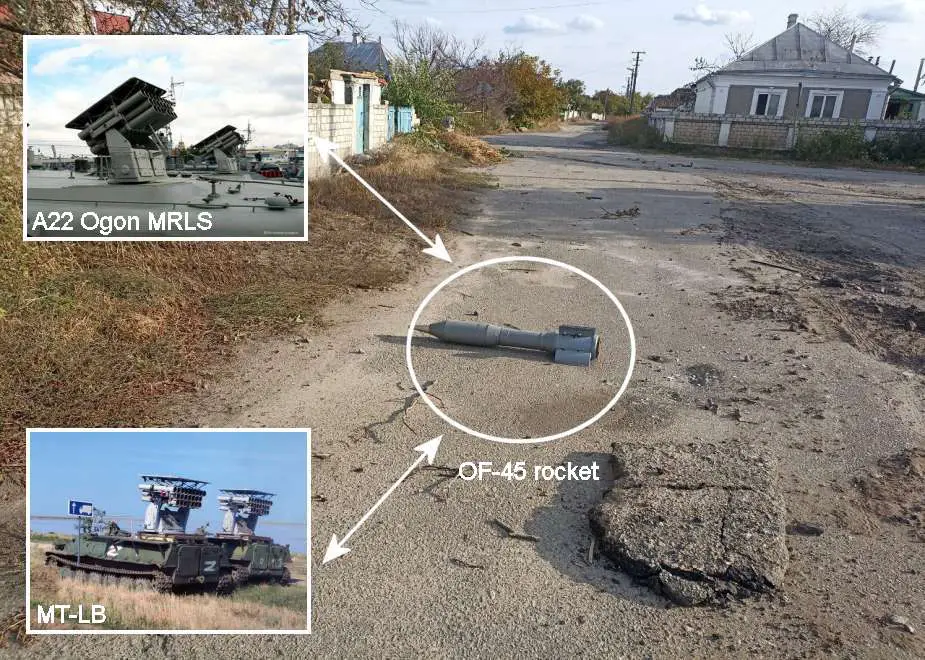MT-LB armored vehicle fitted with A-22 Ogon naval rocket launcher in Ukraine
On March 5, 2024, Patrick Senft posted photos on his Twitter account revealing the use of an OF-45 rocket, presumably launched from an A-22 naval multiple rocket launcher system (MBRLS) mounted on an MT-LB armored vehicle. This use had already been reported in September 2023 by various media outlets. However, the images shared by Senft indicate that the rocket launch was defective, highlighting potential issues in adapting these naval systems for terrestrial use.
Follow Army Recognition on Google News at this link

Russian OF-45 rocket presumably launched from an A-22 naval multiple rocket launcher system (MBRLS) mounted on an MT-LB armored vehicle (Picture source: Ukraine social media)
In Ukraine, it is not uncommon to see hybrid vehicles, with Ukrainians and Russians competing in creativity on this front. Here, we see an MT-LB equipped with an A-22 Ogon MRL system. This adaptation highlights certain challenges, including the effectiveness and reliability of the naval rocket system in a ground combat scenario. A defective OF-45 rocket shown in Senft's Twitter post suggests potential problems with the system's performance in its new role.
The A-22 system is a 140mm caliber rocket launcher designed for naval platforms, including landing crafts and hovercraft. Its adaptation to the MT-LB, an armored personnel carrier, marks an unprecedented cross-domain use of the system. The launcher operates with a variety of unguided rockets, such as OF-45, ZZh-45 (incendiary), and OFD-45, designed for different operational needs. The OF-45 rocket, for example, has a range of 4500 meters and carries a warhead of 5.56 kilograms, while the OFD-45 can reach up to 9500 meters and has a warhead of 6 kilograms.
The MT-LB is a multi-purpose armored vehicle of Soviet origin that has been in service since the 1970s. Designed for various roles, including troop transport, command, and control, the vehicle is powered by a 240-horsepower diesel engine, allowing it to reach speeds of up to 61 km/h on roads and 30 km/h off-road. Weighing approximately 11.9 tons, the MT-LB has a payload capacity of 2.5 tons and can carry up to 11 personnel. Its armor protects against small arms fire and artillery shell splinters, making it a reliable choice for various military applications.
Although the setup may seem unstable, the primary objective is likely to provide a mobile platform capable of delivering a high volume of indirect fire for suppression purposes. This hybrid is certainly not a "game-changer," but it remains interesting to see what such a combination can bring to the armed forces present in Ukraine.
The integration of naval rocket systems like the A-22 on armored vehicles like the MT-LB in Ukraine illustrates an attempt to increase the versatility and firepower of military equipment by adapting existing material to specific operational conditions. This approach aims to enhance indirect fire capabilities without the need for developing new platforms, revealing an innovative use of available resources. However, this strategy could also highlight and potentially exacerbate challenges within the Russian armament production chain, faced with the need to adjust its production lines to support this hybridization of terrestrial and naval equipment.
The adaptation provides tactical flexibility in various scenarios, combining mobility and firepower, but raises questions about Russia's ability to maintain a stable and efficient supply of components and ammunition for these hybrid systems. In addition to potential logistical and maintenance challenges, this initiative might require adjustments in armament production, affecting resource planning and distribution. While innovation in the use of military equipment is crucial in current conflicts, it also necessitates consideration of the implications on the production chain and logistical support, highlighting the need for adaptive management in response to changing operational needs and strategic objectives. Moreover, resorting to hybrid solutions could indicate deeper difficulties, potentially reflecting an inability to maintain an adequate overall armament production.























